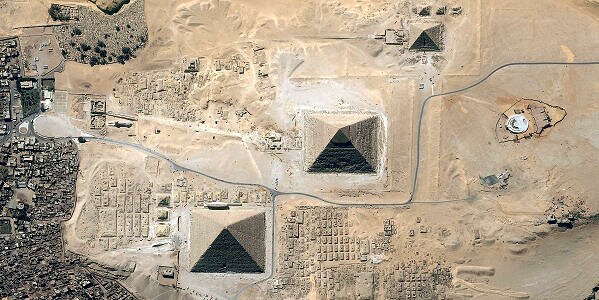|
|
|||||||
|
|
The pyramids of Giza
It was during the Old Kingdom (c.2700-2200 BC), that twenty-one pyramids were built, known to historians as the "Golden Age" of pyramid building, and reaching its technological apogee with Khufu's (c.2589-2566 BC) "Great Pyramid". During this five hundred year period, some eight million cubic metres of stone (not including temples, causeways and ramps) was required to construct these twenty-one pyramids. The three pyramids on the Giza plateau, built for the 4th dynasty kings, Khufu, Khafre and Menkaure, contained approximately five million cubic metres of stone, amounting to 63% of the total stone quarried.
Frustratingly, the ancient Egyptians never left any written records on how these monuments were constructed. What we do know is that the Great Pyramid of Khufu was the result of a continuing architectural process that began with Djoser's Step Pyramid at nearby Saqqara. Archaeological evidence points to the pharaoh Huni (c.2637-2613 BC) for initiating the first geometric pyramid. Following Imhotep's original step design, his architects embellished upon it by having the steps filled in with casing stones to form a smooth-sided pyramid, a design feature that all future pyramids would imitate. Nobody is quite sure what brought about this change in design, but it may allude to a change in ancient Egyptian beliefs. We find a significant change in doctrine, which saw a shift away from a stellar cult - worshipping the circumpolar stars, to a solar cult and the worship to the sun god Re, in which the pyramid acted as a symbolic "stairway to heaven". Indeed, if the reason for a change in pyramid design was due to a change in religious doctrine, it was however, a gradual process, as Khufu's pyramid incorporates both solar and stellar religious elements. It is geometric in design with four smooth faces that represent the solar aspect, whilst internally the pyramid contains four small shafts that appear to align with celestial star Sirius and the constellations of Orion's belt - a reminder of its stellar function.
Construction
In addition, Herodotus was the first to mention the use of slave labour to build the pyramids.
A Jewish Roman historian Josephus (c.1 AD) expounded the contentious slavery theory by stating that the Hebrews were "worn out during their toils, being forced to build the pyramids". We now know that this was not the case at all - in fact a volunteer workforce in the region of 20,000 built the pyramids over a twenty year period. The bulk of the workforce comprised of the "neferu", meaning "the beautiful ones"; youths who were employed on a rotational "corvee" system (a three month period of national service).
Alignment
There is no doubt that the pyramids were laid out with great precision to align with the four cardinal points. Nevertheless, when a stellar chart is super imposed over a map of Giza, there are some stars, which have no corresponding pyramids, and pyramids, which have no corresponding stars in Orion, or any other constellation. A more plausible explanation that has been suggested is that their diagonal line pointing north-east aligns with Heliopolis, the home of the "ben-ben" stone, and south-west towards Abydos, the entrance to the Underworld. A theory that is now widely accepted, is that the four "air shafts" in Khufu's pyramid have religious and cultic significance. They are oriented towards Orion, Sirius and the northern polar stars, so that the dead king's ka spirit could ascend to the heavens and become one with these stars. Boat pits The pyramids are also reported to possess strange mystical properties, such as being the keepers of ancient secret religious and scientific knowledge, be able to re-sharpen blunt knives, prevent food from rotting, have healing properties and even have the ability to achieve immortality. Suffice to say non-of these claims have ever been substantiated. Proceed onto the Great Sphinx >>
|
||||||

|
|||||||
|
|||||||









 The area known as the Giza Plateau, with its three colossal man-made mountains is arguably the most instantly recognisable landmark in the world, and is the only remaining wonder from the Seven Wonders of the World. The ancient Egyptian's name for a pyramid was "Mer", which may have meant "place of ascension". However, the modern name of pyramid, derives its name from the Greek word "pyramis", the name given to a pointed wheat cake.
The area known as the Giza Plateau, with its three colossal man-made mountains is arguably the most instantly recognisable landmark in the world, and is the only remaining wonder from the Seven Wonders of the World. The ancient Egyptian's name for a pyramid was "Mer", which may have meant "place of ascension". However, the modern name of pyramid, derives its name from the Greek word "pyramis", the name given to a pointed wheat cake.

 Experimentation using Herodotus's technique proved to be highly inadequate. The remains of earthen ramps behind the first pylon of Karnak Temple have given Egyptologists a clue to the method used to transport the millions of blocks from the quarries to the top of the pyramid. Stones loaded onto sledges, dragged along a lubricated ramp, using a mixture of water and animal fat, proved the most economical method of constructing a pyramid, although this method is not without its critics, who highlight the many "drawbacks" using this process of construction. In reality, we may only hazard a logical guess, based on archaeological evidence on how the pyramids were constructed, but it seems highly likely that they were constructed using a combination of techniques, which, to date, lie undiscovered.
Experimentation using Herodotus's technique proved to be highly inadequate. The remains of earthen ramps behind the first pylon of Karnak Temple have given Egyptologists a clue to the method used to transport the millions of blocks from the quarries to the top of the pyramid. Stones loaded onto sledges, dragged along a lubricated ramp, using a mixture of water and animal fat, proved the most economical method of constructing a pyramid, although this method is not without its critics, who highlight the many "drawbacks" using this process of construction. In reality, we may only hazard a logical guess, based on archaeological evidence on how the pyramids were constructed, but it seems highly likely that they were constructed using a combination of techniques, which, to date, lie undiscovered.